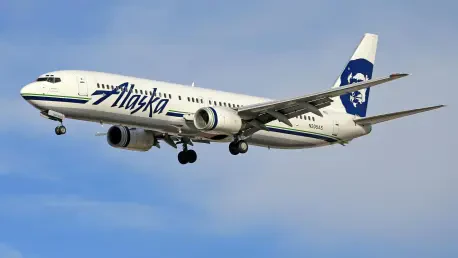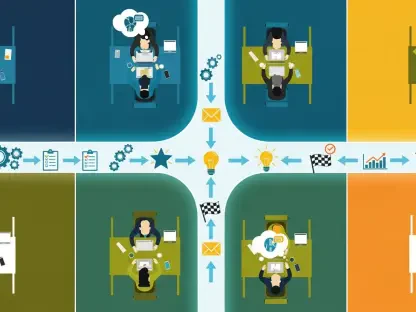In an era where employee engagement is crucial to the sustainability of any business, Alaska Airlines has set a benchmark that few can rival. The airline implemented a strategic overhaul of its internal communications, resulting in an impressive 99.5% employee engagement rate, a milestone that underscores the importance of effective communication within a distributed workforce. This accomplishment is particularly noteworthy in the aviation industry, where coordination and safety are paramount. By addressing internal communication challenges, Alaska Airlines has ensured that all employees, from flight attendants to ground staff, feel informed and involved, thereby enhancing operational efficiency and morale.
Redefining Communication: Alaska Airlines’ Strategic Approach
The Communication Challenge
Alaska Airlines encountered significant hurdles in internal communication, which were indicative of a broader industry issue: ineffective communication contributing to employee dissatisfaction and high turnover rates. Staffbase’s research quantified this challenge, noting that 58% of employees considering job changes cite poor internal communication as a primary reason. The issue was most pronounced among frontline workers, with only 10% reporting high satisfaction with how information was shared. This communication gap not only threatened employee retention but also jeopardized operational effectiveness, crucial in industries where safety and precise coordination are non-negotiable. Alaska Airlines’ management recognized that existing communication methodologies were inadequate, particularly in reaching its diverse workforce of pilots, crew, and support staff.
Overhaul of Internal Communication
In response to these challenges, Alaska Airlines embarked on a comprehensive revamp of its communication strategies. Previously reliant on outdated systems like scattered emails and bulletin boards, the airline shifted towards a centralized, mobile-first platform crafted in collaboration with Staffbase. Leading this transformation was David Henrich, senior manager of communications operations. His vision was clear: transition from a disjointed communication structure to one that is seamless and inclusive. This involved moving away from “one-size-fits-all” solutions and toward customized strategies that catered specifically to the needs of various employee groups, particularly frontline workers. The initiative was meticulously planned and executed over this period, ensuring that the transition was smooth and all stakeholders were adequately prepared.
Strategic Implementation and Phased Rollout
Deliberate Transformation
Alaska Airlines employed a phased rollout strategy to introduce the new communication platform, starting with a kickoff in early 2023 and culminating in a full-scale deployment by August of the same year. This deliberate, gradual approach mitigated potential disruptions and allowed for ongoing feedback from employees at each stage. Henrich’s “deliberate and slow-to-go-fast” methodology underscored the importance of measured implementation, focusing on obtaining employee buy-in and minimizing resistance to change. By incorporating employee insights through surveys and beta testing, the airline crafted a robust transition plan. Each phase was strategically considered, with clear communication to ensure employees were never taken by surprise, thus fostering a positive reception and sustaining momentum.
Achieving High Engagement
The strategic patience paid off as Alaska Airlines surpassed its initial goal of 50% platform adoption within the first year, achieving a remarkable 99.5% engagement rate shortly after the platform’s full launch. Such unprecedented adoption was bolstered by the positive reception among employees, 98% of whom expressed satisfaction with the new communication system. Critically, this included frontline workers, a segment historically difficult to reach due to their distinct working conditions. This success highlighted the effectiveness of a feedback-driven approach, proving that proactive engagement and inclusive planning were essential in driving both technological adoption and employee satisfaction. It exemplified how strategic communication, thoughtfully executed, can transform workforce interactions and dynamics.
Technological and Human Centricity
Balancing Technology and Human Needs
Alaska Airlines’ communication strategy extended beyond mere technology deployment. While the new platform facilitated crucial interactions, the essence of its success lay in its human-centric design. The article emphasizes that technological solutions should enhance, not replace, genuine human connections within working environments. By ensuring that new tools were intuitive and tailored to employees’ needs, Alaska Airlines effectively bridged the gap between technology and workforce expectations. Henrich’s commitment to an “employee-centric and tech agnostic” framework underscored this point, ensuring that platforms were not only advanced but also accessible and relevant to all employees, thus improving overall job satisfaction and operational effectiveness.
Implications of Success
The airline’s success offers significant insights for enterprises across similar sectors, highlighting the critical role of communication in ensuring compliance, safety, and employee engagement, particularly in high-stakes environments. For Alaska Airlines, enhancing internal communication is intertwined with broader organizational imperatives, such as safety protocols and regulatory compliance. Real-time updates and a centralized communication hub streamlined operations and compliance management, reducing risks associated with information lag or inaccuracies. This integration not only facilitated smoother day-to-day operations but also delivered tangible benefits, creating an environment where employees feel more connected and valued, thus improving overall performance and organizational resilience.
Broader Industry Impact and Future Vision
Lessons for HR Leaders
The transformation undertaken by Alaska Airlines presents a compelling case study for HR professionals, offering strategies for overcoming communication challenges in distributed workforces. Central to their approach was the recognition of the importance of strategic alignment between management and leadership, ensuring that communication initiatives were not merely top-down edicts but integrated into the organizational culture. The case illustrates how phased rollouts, continuous feedback loops, and management support are vital for innovation that genuinely enhances employee experiences and satisfaction. The initiative’s success underscores the necessity of aligning communication strategies with operational and employee engagement objectives, ensuring that positive change is sustainable and far-reaching.
Ongoing Developments and Future Applications
In today’s business climate, where employee engagement is vital for any company’s sustainability, Alaska Airlines has emerged as a leading example that few can match. The airline has undertaken a comprehensive overhaul of its internal communication strategy, achieving an exceptional employee engagement rate of 99.5%. This milestone highlights the critical role of effective communication within a dispersed workforce. This achievement is particularly significant in the aviation sector, where coordination and safety are essential. Alaska Airlines’ efforts have successfully overcome internal communication hurdles, ensuring all personnel—from flight attendants to ground crew—remain informed and active in their roles. This initiative not only boosts operational efficiency but also enhances employee morale. By fostering an environment where every team member feels connected and valued, the airline has solidified its commitment to high standards and safety, setting a benchmark for others in the industry to follow.









